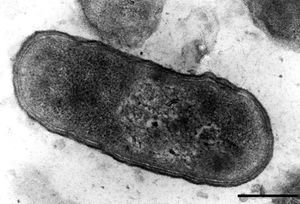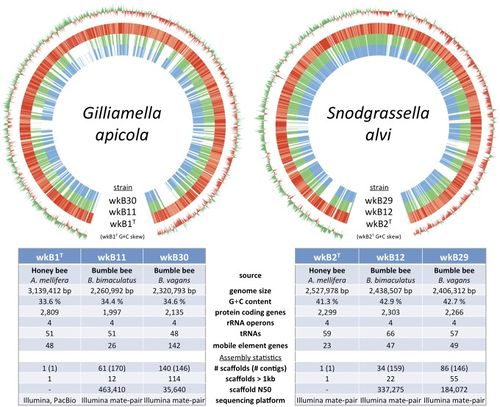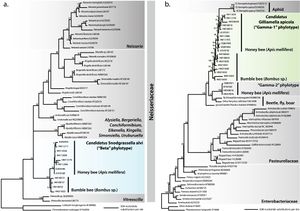Snodgrassella alvi wkB2: Difference between revisions
| Line 36: | Line 36: | ||
==Genome Structure== | ==Genome Structure== | ||
[[File:S.alvi.jpg|500px|thumb|right | [[File:S.alvi.jpg|500px|thumb|right]] | ||
===Genome=== | ===Genome=== | ||
The genome of <i> S. alvi </i> wkB2 consists of a singular circular chromosome containing 2,527,978 bp (Kwong 2014). The G+C content is 41.3% (Kwong 2014). | The genome of <i> S. alvi </i> wkB2 consists of a singular circular chromosome containing 2,527,978 bp (Kwong 2014). The G+C content is 41.3% (Kwong 2014). | ||
[[File:phylogenetic_alvi.jpg|300px|thumb|]] | |||
====Annotated Genes==== | ====Annotated Genes==== | ||
Revision as of 23:08, 29 April 2020
Classification
Taxonomy
Domain: Bacteria
Phylum: Proteobacteria
Class: Betaproteobacteria
Order: Neisseriales
Family: Neisseriaceae
Genus: Snodgrassella
Species: alvi
Strain: wkB2
|
NCBI: Taxonomy |
Names
Snodgrassella alvi wkB2
Candidatus Snodgrassella alvi wkB2 (previously)
S. alvi wkB2
Description and Significance
S. alvi wkB2 is a core member of the western honey bee ( Apis mellifera ) gut microbiota (Kwong, 2012). The cells are short gram negative rods. On agar, S. alvi wkB2 forms smooth white round colonies (Kwong, 2012). This cell is non-motile (Kwong 2013).
Snodgrassella was so named in honor of Robert Evans Snodgrass was a prominent figure studying insect physiology and had described Apis mellifera (Martinson, 2012). alvi refers to the latin word "alvus" which refers to the bowels or too bees (Martinson, 2012). The strain was described by Waldon Kwong who's initials are "w.k."
Initially, the name "Candidatus" was added to the front of Snodgrassella alvi because its initial discovery was through gene sequencing and had not been cultivated yet (Martinson, 2012).
Genome Structure
Genome
The genome of S. alvi wkB2 consists of a singular circular chromosome containing 2,527,978 bp (Kwong 2014). The G+C content is 41.3% (Kwong 2014).
Annotated Genes
There are 2295 annotated genes and 2193 of them are protein coding, 76 are non-coding, the rest (26) are pseudogenes (Ncbi.nlm.nih.gov).
A few notable annotated gene functions include genes that code for many pathogen associated functions. One gene codes for nonribosomal peptide synthesis of siderophores (Kwong 2014). The type 6 secretion system (T6SS) (Kwong 2014).
Cell Structure, Metabolism and Life Cycle
Interesting features of cell structure; how it gains energy; what important molecules it produces.
Cell Structure
S. alvi wkB2 is gram negative. It has a type IV pilli structure and YadA-like adhesins which are used to interact with the host gut epithelium.
Metabolism
S. alvi wkB2 is an obligate aerobe. S. alvi wkB2 has transportation systems for taking up carboxylates like citrate, malate, & α-ketoclutarate. These can then be used in the TAC cycle. Transportation systems within S. alvi wkB2 can also allow for the uptake of lactate which can be directly converted into pyruvate through lactate dehydrogenase.
Lost Metabolic Pathways
Evidence has been found suggesting that S. alvi was able to take up and break down carbohydrates, but has since lost that ability (Kwong 2014). The Glycolosis pathway, Pentose phosphate pathway, & Entner-Doudoroff pathway have all lost essential enzymes (Kwong 2014). These pathways are typically used to convert sugars to pyruvate.
Biochemical Tests
Nitrate reductase: Positive
Catalase: Positive
Urease: Positive
Cytochrome C Oxidase: Negative
β-Glucosidase: Negative
Indole production: Negative
Gelatinase: Negative
β-Galactosidase: Negative
Arginine dihydrolase: Negative
H2S production: Negative
Haemolysis: Negative
The above data was from the initial proposed characterization of S. alvi (Kwong, 2012).
Life Cycle
S. alvi wkB2 lives its entire natural life within the gut of A. mellifera . Cultivation of S. alvi wkB2 in vivo (in A. mellifera ) needs no substrate or assistance outside of the bee's regular diet.
This strain can also be cultivated in vitro on the following agars: Heart Infusion, Heart Infusion supplemented with Sheep's Blood, Columbia supplemented with Sheep's Blood (CBA), & R2 Agar (Barrick Lab, 2020). Liquid cultivation of S. alvi wkB2 is typically on Insectargro, Salt-free LB, or R2 Liquid Media (Barrick Lab, 2020).
On solid or liquid media, in vitro cultivation of S. alvi wkB2 is typically at 35°C and 5% CO2 (Barrick Lab, 2020).
Ecology
Bee Gut Importance
Within the bee gut, S. alvi wkB2 plays a vital role in O2 consumption keeping the gut of the bee anaerobic (*). S. alvi wkB2 is also a primary biofilm former, forming a layer around the ileum (*).
Ecological Importance
For A. mellifera two pests that have been attributed to the large decline in honey bee populations are, the Varroa mite ( Varroa destructor ) and the Deformed Wing Virus (DWV)
A transformed S. alvi wkB2 cells using RNAi have been proposed as a solution to the decreasing honey bee population (Leonard 2020). It has been shown that these synthetic S. alvi wkB2 cells can sucessfully colonize A. mellifera in the same part of the ileum that it usually occupies.
This engineered microbe was transformed with a plasmid coding for double stranded RNA (dsRNA) targeting an essential mRNA on the deformed wing virus which plagues the western honey bee. Leonard et al. were able to show an increase in bee survival for bees incoulated with the DWV and had sucessful colonizations of transformed S. alvi wkB2 cells.
In another experiment, S. alvi wkB2 was transformed with a plasmid which coded for dsRNA which targeted 14 essential Varroa mite genes. They were also able to show a decrease in survival rates for the Varroa mites feeding on these bees.
References
Kwong, W., Engel, P., Koch, H. and Moran, N., 2014. Genomics and host specialization of honey bee and bumble bee gut symbionts. Proceedings of the National Academy of Sciences, 111(31), pp.11509-11514.
Barricklab.org. 2020. Barrick Lab :: Protocolsculturingsnodgrassellaalvi. [online] Available at: <https://barricklab.org/twiki/bin/view/Lab/ProtocolsCulturingSnodgrassellaAlvi> [Accessed 29 April 2020].
Kwong, W. and Moran, N., 2012. Cultivation and characterization of the gut symbionts of honey bees and bumble bees: description of Snodgrassella alvi gen. nov., sp. nov., a member of the family Neisseriaceae of the Betaproteobacteria, and Gilliamella apicola gen. nov., sp. nov., a member of Orbaceae fam. nov., Orbales ord. nov., a sister taxon to the order 'Enterobacteriales' of the Gammaproteobacteria. INTERNATIONAL JOURNAL OF SYSTEMATIC AND EVOLUTIONARY MICROBIOLOGY, 63(Pt 6), pp.2008-2018.
Martinson, V., Moy, J. and Moran, N., 2012. Establishment of Characteristic Gut Bacteria during Development of the Honeybee Worker. Applied and Environmental Microbiology, 78(8), pp.2830-2840.
Ncbi.nlm.nih.gov. 2020. Home - Gene - NCBI. [online] Available at: <https://www.ncbi.nlm.nih.gov/gene> [Accessed 29 April 2020].
Author
Page authored by Samantha Worthington, student of Prof. Jay Lennon at Indiana University.



